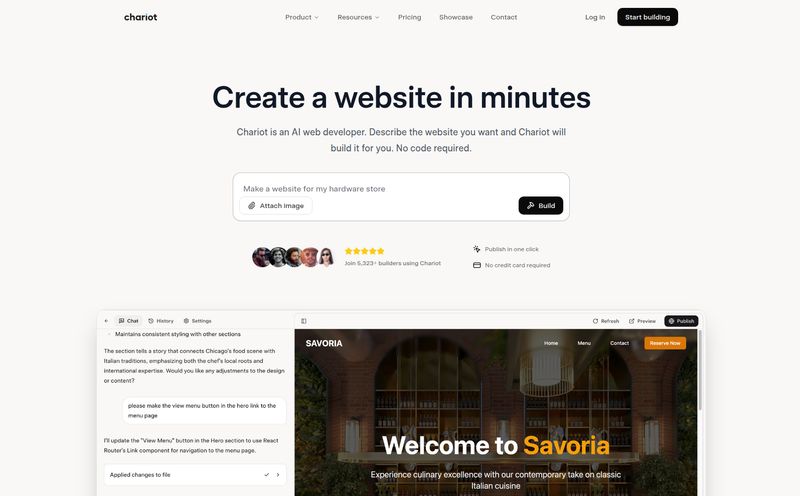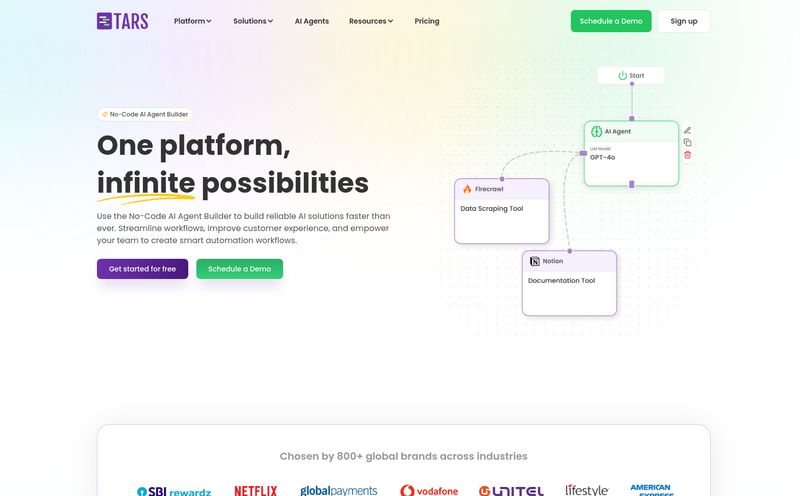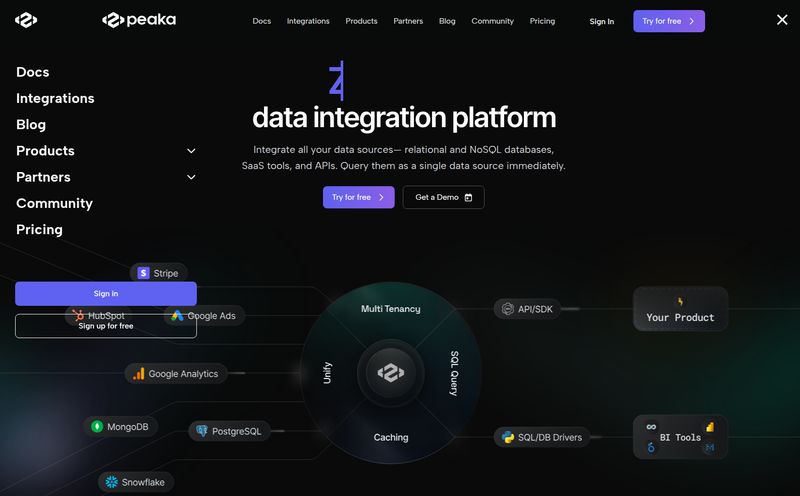If you're anything like me, you've spent a good chunk of the last couple of years with your head buried in ChatGPT, Claude, or some other LLM. It’s been wild, right? We've gone from simple prompts to trying to build these ridiculously complex chains of commands, hoping the AI doesn't get distracted by a digital squirrel halfway through. I've personally tried to build content clusters using nothing but a long, convoluted prompt, and let me tell you, the results are... inconsistent. It’s like trying to give a chef a 20-step recipe verbally and hoping they remember everything perfectly. Sometimes you get a masterpiece; other times, you get a burnt mess.
So when I first heard about a tool called ModularMind, my ears perked up. The pitch? A no-code, drag-and-drop builder for creating complex AI workflows. It sounded like someone was finally trying to build what we've all been sketching on napkins: a way to visually map out our AI tasks instead of just shouting into the void of a text box. A visual flowchart for AI. The promise of finally getting some structure and reliability into my AI-powered marketing efforts was just too good to ignore.
So, What Exactly Is ModularMind Anyway?
At its core, ModularMind is a platform that gives you a visual canvas to build AI automations. Instead of writing one monster prompt, you create smaller, individual prompts or 'modules' and then connect them. Think of it like this: one module could be 'Generate 5 blog titles for the keyword [X]', the next could be 'Analyze these titles for emotional impact and pick the best one', and a third module could be 'Write a 1500-word blog post based on the winning title'.
You literally drag these little blocks onto a canvas and draw lines between them to show the flow of information. The output of one block becomes the input for the next. It’s a concept that programmers will recognize from visual programming languages, but here it’s built for the rest of us—the marketers, the founders, the content creators who don't want to mess with APIs and Python scripts. It’s all about merging, appending, and executing these stacked prompts to get a much more sophisticated result than a single prompt could ever deliver.

Visit ModularMind
Like Building with AI Bricks
The best way I can describe it is like playing with LEGOs. Seriously. Each prompt is a different kind of brick. You have your 2x4 red brick for 'generating ideas,' your thin blue one for 'rewriting in a specific tone,' and that weird, specialized corner piece for 'summarizing this text for a tweet.' On their own, they're just simple blocks. But when you start snapping them together on that big green baseplate—the ModularMind canvas—you can build a castle. Or a spaceship. Or, in our case, a fully automated content generation engine.
This visual approach is, in my opinion, a huge mental shift. It makes the whole process less about 'prompt engineering' and more about 'process design.' You’re not just a wordsmith; you’re an architect designing a system. And for a systems-brained SEO guy like me, that is incredibly appealing. It brings a sense of order to the chaos of creative AI.
My Favorite Parts of the ModularMind Approach
I'm still kicking the tires, but a few things have already jumped out at me as being genuinely exciting. It’s not just another wrapper for an AI API; it feels like a different way of thinking.
The No-Code Dream Is Actually Real
We hear “no-code” thrown around so much it’s almost lost all meaning. But here, it feels legit. The drag-and-drop interface is intuitive. If you've ever used a tool like Canva or Miro, you’ll feel right at home. The barrier to entry is incredibly low. You don't need to know what a 'JSON object' is or how to handle an 'API key' (well, probably not for the basic stuff, anyway). This opens the door for so many people who have brilliant ideas for automation but get stopped cold by teh technical hurdles.
Tackling Actually Complex Workflows
This is the big one for me. Simple AI tasks are easy. What's hard is creating a sequence of dependent tasks. For instance, a real workflow I'd love to build:
- Input: A competitor's URL.
- Step 1: Scrape the H2s and H3s from the article.
- Step 2: Analyze the structure and identify the core topics covered.
- Step 3: Generate a new, improved outline that covers the same topics but adds a unique angle.
- Step 4: Write a draft based on that new outline.
- Step 5: Create a series of social media posts to promote the article.
Trying to do that in one prompt is a recipe for disaster. But with a modular approach? It suddenly seems possible. Each step is its own contained operation. It's a much more robust way to build, and frankly, it's the only way this kind of advanced automation is going to become reliable for business use.
Where I'm Still a Bit Hesitant (The Catch)
Now, it's not all sunshine and automated roses. As with any new tool that promises the world, I've got my reservations. It’s my job to be skeptical, after all. It’s how we avoid falling for the hype and focus on what actually drives traffic and conversions.
The Big Pricing Question Mark
Here’s the elephant in the room: I can't find any pricing information. As of this writing, their site is pretty tight-lipped about the cost. Is it a per-workflow model? A monthly subscription? Will it be based on the number of AI calls you make? This is a massive question for anyone looking to adopt this into their daily routine. An amazing tool that costs a fortune is, for most of us, not an amazing tool. I'm hoping for a tiered system, maybe a free plan for basic workflows, but until they release those details, it's hard to give it a full-throated endorsement.
How Deep Does the Rabbit Hole Go?
The other thing is the current lack of detail on specific features. The concept is fantastic, but the devil is in the details. Can I integrate it with other tools? Can I pull in live data from a URL or a Google Sheet? Can I schedule workflows to run automatically? The marketing materials promise 'limitless creativity,' but I need to know the practical limits. These are the kinds of features that separate a fun toy from an indispensable business tool, like Ahrefs or SEMrush have become for SEOs. I’m optimistic, but the jury's still out.
So, Is ModularMind Worth Your Time?
Even with the unanswered questions, my gut feeling is a resounding yes. At the very least, it's worth getting on their radar. The concept of a no-code, visual AI workflow builder isn't just a gimmick; I genuinely believe it’s the next logical step in making AI practical for everyone. It solves a real, tangible problem that I and many others in the digital marketing space face every single day.
It’s a move away from the 'magic black box' view of AI and toward something more understandable, more controllable, and ultimately, more powerful. It’s a tool that could let us build the exact automated marketing and content machines we've been dreaming of. I'll be watching this one closely, and as soon as I get my hands on more concrete details about its capabilities and pricing, you can bet I'll be back with an update.
Frequently Asked Questions
- What is ModularMind?
- ModularMind is a no-code AI platform that lets you build complex AI automations using a visual, drag-and-drop canvas. You connect different AI prompts (modules) together to create sophisticated workflows without writing any code.
- Do I need to be a programmer to use ModularMind?
- Nope! That's the main appeal. It’s designed specifically for non-coders like marketers, writers, and entrepreneurs. If you can make a flowchart, you can likely use ModularMind.
- How does ModularMind work with ChatGPT?
- It uses the power of large language models like ChatGPT to execute the tasks within each module. You design the workflow on the canvas, and ModularMind handles the communication with the AI in the background to get the job done.
- Could this replace a tool like Zapier?
- That's a great question. It's possible it could replace parts of what Zapier does, especially for tasks that are heavily reliant on content generation or AI analysis. However, Zapier's strength is its massive library of integrations with thousands of apps. ModularMind seems more focused on the AI processing itself. They could be more powerful when used together, rather than as replacements.
- How much does ModularMind cost?
- As of now, pricing information isn't publicly available. This is one of the main unknowns, and we're all eagerly awaiting more details on their pricing structure.
References and Sources
For more on the rise of no-code platforms and their impact, I'd recommend checking out some of the discussions on platforms like Indie Hackers' no-code community. For a deeper understanding of AI prompt chaining, the OpenAI community forums are a goldmine of user experiments and techniques.



